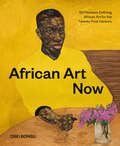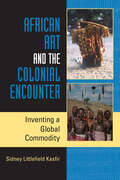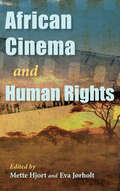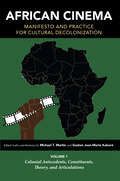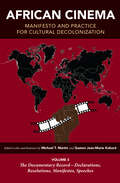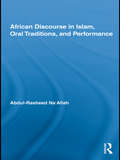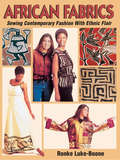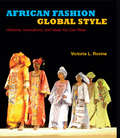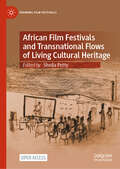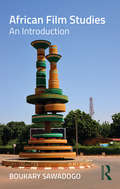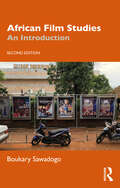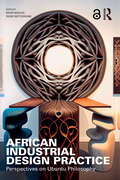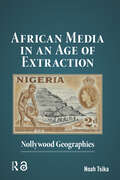- Table View
- List View
African Art Now: 50 Pioneers Defining African Art for the Twenty-First Century
by Osei BonsuThis deluxe hardcover survey, featuring profiles of 50 artists on the rise, is the definitive guide to contemporary African art.With African artists attracting sizable audience numbers to museums, setting sky-high auction records, and appearing in mainstream press, it has become impossible to overlook the cultural significance of contemporary African art today. Author and curator Osei Bonsu's engaging profiles of leading African artists—along with gorgeous full-color reproductions of their work—introduce readers to a generation of movers and shakers whose innovative artwork reflects on Africa as both an idea and an experience. Using diverse forms, languages, and expressions to articulate what it means to be a part of the world, these artists generate alternate histories and imaginative futures—work that is both personal and political, universal and incredibly specific. Their work helps define contemporary African art as a vast artistic and cultural movement.STELLAR ROSTER OF ARTISTS: Amoako Boafo, Njideka Akunyili Crosby, Tunji Adeniyi-Jones, Bronwyn Katz—from household names to up-and-coming artists, African Art Now features some of the most exciting artists working today. IMPORTANT AND TIMELY: Over the past two decades, contemporary African art has become part of the global mainstream, inspiring countless exhibitions, fairs, and auctions around the world. And yet, African art remains overlooked as an area of dedicated study due to continued academic and cultural bias. This book shines a spotlight on the artists whose wide-ranging accomplishments represent the shifting dynamics and boundless possibilities of African art today. Perfect for:Artists, art collectors, art lovers, and museumgoersEducators and studentsAnyone interested in learning about contemporary African art
African Art Reframed: Reflections and Dialogues on Museum Culture
by Bennetta Jules-Rosette J.R. OsbornOnce seen as a collection of artifacts and ritual objects, African art now commands respect from museums and collectors. Bennetta Jules-Rosette and J.R. Osborn explore the reframing of African art through case studies of museums and galleries in the United States, Europe, and Africa. The authors take a three-pronged approach. Part One ranges from curiosity cabinets to virtual websites to offer a history of ethnographic and art museums and look at their organization and methods of reaching out to the public. In the second part, the authors examine museums as ecosystems and communities within communities, and they use semiotic methods to analyze images, signs, and symbols drawn from the experiences of curators and artists. The third part introduces innovative strategies for displaying, disseminating, and reclaiming African art. The authors also propose how to reinterpret the art inside and outside the museum and show ways of remixing the results. Drawing on extensive conversations with curators, collectors, and artists, African Art Reframed is an essential guide to building new exchanges and connections in the dynamic worlds of African and global art.
African Art and Agency in the Workshop
by Till Förster Sidney Littlefield KasfirThe role of the workshop in the creation of African art is the subject of this revelatory book. In the group setting of the workshop, innovation and imitation collide, artists share ideas and techniques, and creative expression flourishes. African Art and Agency from the Workshop examines the variety of workshops, from those which are politically driven or tourist oriented, to those based on historical patronage or allied to current artistic trends. Fifteen lively essays explore the impact of the workshop on the production of artists such as Zimbabwean stone sculptors, master potters from Cameroon, wood carvers from Nigeria, and others from across the continent.
African Art and the Colonial Encounter: Inventing A Global Commodity (African Expressive Cultures)
by Sidney Littlefield KasfirFocusing on the theme of warriorhood, Sidney Littlefield Kasfir weaves a complex history of how colonial influence forever changed artistic practice, objects, and their meaning. Looking at two widely diverse cultures, the Idoma in Nigeria and the Samburu in Kenya, Kasfir makes a bold statement about the links between colonialism, the Europeans' image of Africans, Africans' changing self representation, and the impact of global trade on cultural artifacts and the making of art. This intriguing history of the interaction between peoples, aesthetics, morals, artistic objects and practices, and the global trade in African art challenges current ideas about artistic production and representation.
African Art as Philosophy: Senghor, Bergson, and the Idea of Negritude
by Souleymane Bachir DiagneThis critically acclaimed study offers a distinct, incisive look at how Senegalese philosopher Senghor sees in African art the most acute expression of Bergson&’s philosophy.Léopold Sédar Senghor (1906–2001) was a Senegalese poet and philosopher who in 1960 also became the first president of the Republic of Senegal. In African Art as Philosophy, Souleymane Bachir Diagne uses a unique approach to reading Senghor&’s influential works, taking as the starting point for his analysis Henri Bergson&’s idea that in order to understand philosophers, one must find the initial intuition from which every aspect of their work develops. In the case of Senghor, Diagne argues that his primordial intuition is that African art is a philosophy.To further this point, Diagne looks at what Senghor called the &“1889 Revolution&” (the year Bergson&’s Time and Free Will was published), as well as the influential writers and publications of that period—specifically, Nietzsche and Rimbaud. The 1889 Revolution, Senghor claims, is what led him to the understanding of the &“Vitalism&” at the core of African religions and beliefs that found expression in the arts.
African Art in Motion
by Robert Farris ThompsonThis title is part of UC Press's Voices Revived program, which commemorates University of California Press’s mission to seek out and cultivate the brightest minds and give them voice, reach, and impact. Drawing on a backlist dating to 1893, Voices Revived makes high-quality, peer-reviewed scholarship accessible once again using print-on-demand technology. This title was originally published in 1974.
African Art, Interviews, Narratives: Bodies of Knowledge at Work (African Expressive Cultures)
by Joanna Grabski and Carol MageeJoanna Grabski and Carol Magee bring together a compelling collection that shows how interviews can be used to generate new meaning and how connecting with artists and their work can transform artistic production into innovative critical insights and knowledge. The contributors to this volume include artists, museum curators, art historians, and anthropologists, who address artistic production in a variety of locations and media to question previous uses of interview and provoke alternative understandings of art.
African Battle Traditions of Insult: Verbal Arts, Song-Poetry, and Performance (African Histories and Modernities)
by Tanure OjaideThis book explores the “battles” of words, songs, poetry, and performance in Africa and the African Diaspora. These are usually highly competitive, artistic contests in which rival parties duel for supremacy in poetry composition and/or its performance. This volume covers the history of this battle tradition, from its origins in Africa, especially the udje and halo of the Urhobo and Ewe respectively, to its transportation to the Americas and the Caribbean region during the Atlantic slave trade period, and its modern and contemporary manifestations as battle rap or other forms of popular music in Africa. Almost everywhere there are contemporary manifestations of the more traditional, older genres. The book is thus made up of studies of contests in which rivals duel for supremacy in verbal arts, song-poetry, and performance as they display their wit, sense of humor, and poetic expertise.
African Cinema and Human Rights (Studies In The Cinema Of The Black Diaspora Ser.)
by Edited by Mette Hjort and Eva JørholtEssays and case studies exploring how filmmaking can play a role in promoting social and economic justice. Bringing theory and practice together, African Cinema and Human Rights argues that moving images have a significant role to play in advancing the causes of justice and fairness. The contributors to this volume identify three key ways in which film can achieve these goals: Documenting human rights abuses and thereby supporting the claims of victims and goals of truth and reconciliation within larger communitiesLegitimating, and consequently solidifying, an expanded scope for human rightsPromoting the realization of social and economic right Including the voices of African scholars, scholar-filmmakers, African directors Jean-Marie Teno and Gaston Kaboré, and researchers whose work focuses on transnational cinema, this volume explores overall perspectives, and differences of perspective, pertaining to Africa, human rights, and human rights filmmaking alongside specific case studies of individual films and areas of human rights violations. With its interdisciplinary scope, attention to practitioners&’ self-understandings, broad perspectives, and particular case studies, African Cinema and Human Rights is a foundational text that offers questions, reflections, and evidence that help us to consider film&’s ideal role within the context of our ever-continuing struggle towards a more just global society.
African Cinema: Volume 1: Colonial Antecedents, Constituents, Theory, and Articulations (Studies in the Cinema of the Black Diaspora)
by David Murphy James Burns James E. Genova Michael T. Martin Roy Armes Tom Rice Beti Ellerson Boukary Sawadogo Keyan G. Tomaselli Teshome H. Gabriel Gaston Jean-Marie Kaboré Femi Okiremuete Shaka Odile Goerg Med Hondo Férid Boughedir Haile Gerima Sada Niang Monique Mbeka Phoba Olivier Barlet Clyde R. Taylor Alexie Tcheuyap Esiaba Irobi Stephen A. Zacks Jude Akudinobi Maureen N. Eke Arnold Shepperson Paulin Soumanou Vieyra Claude Forest Samba GadjigoChallenging established views and assumptions about traditions and practices of filmmaking in the African diaspora, this three-volume set offers readers a researched critique on black film. Volume One of this landmark series on African cinema draws together foundational scholarship on its history and evolution. Beginning with the ideological project of colonial film to legitimize the economic exploitation and cultural hegemony of the African continent during imperial rule to its counter-historical formation and theorization. It comprises essays by film scholars and filmmakers alike, among them Roy Armes, Med Hondo, Fèrid Boughedir, Haile Gerima, Oliver Barlet, Teshome Gabriel, and David Murphy, including three distinct dossiers: a timeline of key dates in the history of African cinema; a comprehensive chronicle and account of the contributions by African women in cinema; and a homage and overview of Ousmane Sembène, the "Father" of African cinema.
African Cinema: Volume 2: FESPACO—Formation, Evolution, Challenges (Studies in the Cinema of the Black Diaspora)
by Wole Soyinka Lindiwe Dovey Michael T. Martin Manthia Diawara Beti Ellerson June Givanni Imruh Bakari Sheila Petty Gaston Jean-Marie Kaboré Férid Boughedir Olivier Barlet Ardiouma Soma Sambolgo Bangre Dorothee Wenner M. Africanus Aveh Mahir Saul Mbye Cham Ousmane Sembene Aboubakar Sanogo Teresa Hoefert de Turegano Claire Andrade-Watkins Rod Stoneman Claire Diao Michel Amarger Mustapha Ouedgraogo Colin Dupré Rémi AbegaChallenging established views and assumptions about traditions and practices of filmmaking in the African diaspora, this three-volume set offers readers a researched critique on black film.Volume Two of this landmark series on African cinema is devoted to the decolonizing mediation of the Pan African Film & Television Festival of Ouagadougou (FESPACO), the most important, inclusive, and consequential cinematic convocation of its kind in the world. Since its creation in 1969, FESPACO's mission is, in principle, remarkably unchanged: to unapologetically recover, chronicle, affirm, and reconstitute the representation of the African continent and its global diasporas of people, thereby enunciating in the cinematic, all manner of Pan-African identity, experience, and the futurity of the Black World. This volume features historically significant and commissioned essays, commentaries, conversations, dossiers, and programmatic statements and manifestos that mark and elaborate the key moments in the evolution of FESPACO over the span of the past five decades.
African Cinema: Volume 3: The Documentary Record—Declarations, Resolutions, Manifestos, Speeches (Studies in the Cinema of the Black Diaspora)
by Michael T. Martin Gaston Jean-Marie KaboréChallenging established views and assumptions about traditions and practices of filmmaking in the African diaspora, this three-volume set offers readers a researched critique on black film. Volume Three of this landmark series on African cinema spans the past century and is devoted to the documentation of decoloniality in cultural policy in both Africa and the Black diaspora worldwide. A compendium of formal resolutions, declarations, manifestos, and programmatic statements, it chronologically maps the long history and trajectories of cultural policy in Africa and the Black Atlantic. Beginning with the 1920 declaration of the Rights of the Negro Peoples of the World, which anticipates cinema as we know it today, and the formal oppositional assertions—aspirational and practical. The first part of this work references formal statements that pertain directly to cultural policy and cinematic formations in Africa, while the next part addresses the Black diaspora. Each entry is chronologically ordered to account for when the statement was created, followed by where and in what context it was enunciated.
African Design Futures: Decolonising Minds, Education, Spaces, and Practices (Sustainable Development Goals Series)
by Yaw Ofosu-AsareThis book responds to the question "Is it time to reimagine design education in Africa and decolonise our creative future?" The proposed volume is designed to provide a source of inspiration to readers in imagining their own futures within fields of Creative industries such as performative art, architecture design, industrial design, media production, drawing and illustration, filmmaking, design, documentary, virtual reality, and others. With a focus on decolonising design education in Africa, this book will challenge the dominant capitalist narrative and centre on the needs of African communities. It will provide insights into the challenges and opportunities of decolonising design education and propose alternative models for design education that promote social and environmental sustainability, cultural preservation, and community empowerment. Collectively, the proposed book's accounts bring to life the career possibilities within a rapidly expanding global sector of creativity and innovation with immense cultural, social, political, and economic impact. By exploring new models of creative practice and education that centre on social impact, cultural relevance, and community empowerment, this book will inspire readers to think critically about their own futures in the Creative Industries in Africa.
African Discourse in Islam, Oral Traditions, and Performance (African Studies)
by Abdul-Rasheed Na'AllahThrough an engaged analysis of writers such as Wole Soyinka, Ola Rotimi, Niyi Osundare, and Tanure Ojaide and of African traditional oral poets like Omoekee Amao Ilorin and Mamman Shata Katsina, Abdul-Rasheed Na'Allah develops an African indigenous discourse paradigm for interpreting and understanding literary and cultural materials. Na'Allah argues for the need for cultural diversity in critical theorizing in the twenty-first century. He highlights the critical issues facing scholars and students involved in criticism and translation of marginalized texts. By returning the African knowledge system back to its roots and placing it side by side with Western paradigms, Na'Allah has produced a text that will be required reading for scholars and students of African culture and literature. It is an important contribution to scholarship in the domain of mobility of African oral tradition, and on African literary, cultural and performance discourse.
African Documentary Cinema: Beyond Representation (Routledge Advances in Film Studies)
by Alexie TcheuyapAfrican Documentary Cinema investigates the inception and trajectory of contemporary documentary filmmaking in sub-Saharan African countries and their diasporas. The book challenges critical paradigms that have long prevailed in African film criticism, shedding light on the diverse discourses and evolving aesthetic trends present within documentary films.Situating his analysis within the context of the significant transformation of the African film industry, the author focuses on the development, diversity, and shifting dynamics that have impacted contemporary documentary cinema. Examining the historical, political, sociological, economic, and cultural factors that have facilitated the rise of documentary films—especially those created by female documentarians—the book assesses the emergence of documentary filmmakers spanning different generations. Their training, practices, and innovative perspectives on social, political, and environmental issues ultimately give rise to new frameworks for understanding the bio-documentary genre, issues of gender discrimination, LGBTQIA+ identities, environmental trauma, genocide, and memory on the African continent.This ground-breaking study offers new insight into a rapidly expanding topic and will appeal to students and scholars in the fields of film studies, documentary film, media industry studies, African studies, French, postcolonial studies, politics, and cultural studies.
African Dream Machines: Style, Identity and Meaning of African Headrests
by Anitra NettletonAfrican Dream Machines takes African headrests out of the category of functional objects and into the more rarefied category of ‘art’ objects. Styles in African headrests are usually defined in terms of western art and archaeological discourses, but this book interrogates these definitions of style and demonstrates the shortcomings of defining a single formal style model as exclusive to a single ethnic group. Among the artefacts made by southern African peoples, headrests were the best known. Anitra Nettleton’s study of the uses and forms of headrests opened up a number of art-historical methodologies in the attempt to gain an understanding of form, style and content in African art objects. Her drawings of each and every headrest encountered become a major part of the project.
African Energy Worlds in Film and Media (New Directions in National Cinemas)
by Carmela GarritanoCan you imagine a post-petroleum world? African Energy Worlds in Film and Media joins energy humanists committed to undoing our deep dependence on fossil fuels and advancing equitable energy transitions by advancing this vision with a spotlight on African perspectives.African cinema is a rich and varied medium for investigating the entanglements and social embeddedness of energy with global modernity and for imagining a world that leaves fossil fuels behind for unrealized green energy futures. African Energy Worlds in Film and Media shows us how African cinema makes sensible the energetic aspects of life in the ecological mesh that is planet Earth and grounds us in the everyday of the postcolonial, bringing attention to the enduring legacies of racism and colonialism that unevenly distribute energy-related violence and risk and amplifying Africans' demands for access to the energy networks that undergird modernity. With a focus on feature, documentary, and arthouse films, including canonical films by Ousmane Sembène and Djbril Diop Mambety and new work by emergent directors Nelson Makengo and Djo Tunda Wa Munga, author Carmela Garritano examines how these stories depict an array of energy sources from mineral extraction to wind and the by-products of these energy processes, like plastic and electronic waste.Situated at the intersection of film studies, African studies, and energy humanities, African Energy Worlds in Film and Media analyzes the political, social, and economic dimensions of global energy forms and systems as represented in African cinema.
African Fabrics: Sewing Contemporary Fashion with Ethnic Flair
by Ronke Luke-BooneCreate style with a touch of the exotic Exciting! Inspiring! African fabrics are vibrant, beautiful, and widely available - and they are perfect for contemporary clothing for men, women, and children and great for home decor. An excellent reference for sewers or anyone who is interested in fabrics, culture, and history, this guide will teach you where to buy fabrics, how to choose the right ones, and the best techniques for sewing them. 14 original projects, including Tote bag Apron Tunic Place mats Shawl Pillows Vest Child's loom Full size patterns for three projects Covers these popular African fabrics Mudcloth Fancy prints Kuba cloth Wax prints Korhogo cloth Kente cloth
African Fashion, Global Style
by Victoria L. RovineAfrican Fashion, Global Style provides a lively look at fashion, international networks of style, material culture, and the world of African aesthetic expression. Victoria L. Rovine introduces fashion designers whose work reflects African histories and cultures both conceptually and stylistically, and demonstrates that dress styles associated with indigenous cultures may have all the hallmarks of high fashion. Taking readers into the complexities of influence and inspiration manifested through fashion, this book highlights the visually appealing, widely accessible, and highly adaptable styles of African dress that flourish on the global fashion market.
African Film Festivals and Transnational Flows of Living Cultural Heritage (Framing Film Festivals)
by Sheila PettyThis open access book investigates how flows of knowledge that arise from the African continent travel and are transformed through new contexts of presentation and engagement in new locations. Through case studies on Africa-themed film festivals in Africa, Europe and the Americas, the book explores potential methods of catalyzing a &“transnational flow&” from inception to end that involves attention to process, rather than studying festivals as static cultural products with discrete and isolated categories of programming, presentation, documentation, and networking. The chapters probe how festivals interact with place and location and create journeys of discovery in translating and contextualizing films for specific populations and audiences. The book also focuses on how dialogue is created in a festival-knowledge forum that respects the living nature of cultural heritage as it is received from its original context, presented during film festivals, and passed on to future generations for safeguarding.
African Film Studies: An Introduction
by Boukary Sawadogo<p>African Film Studies: An Introduction is an accessible and authoritative textbook on African cinema as a field of study. The book provides a succinct and comprehensive study of the history, aesthetics, and theory of sub-Saharan African cinematic productions that is grounded in the field of film studies instead of textual interpretations from other disciplines. <p>Bringing African cinema out of the margins into the discipline of mainstream film studies and showcasing the diverse cinematic expressions of the continent, the book covers: <p> <li>Overview of African cinema(s): Questions our assumptions about the continent’s cinematic productions and defines the characteristics of African cinema across linguistic, geographic, and filmic divides. <li>History of African and African-American cinema: Spans the history of film in Africa from colonial import and ‘appropriation of the gaze’ to the quest for individuality. It also establishes parallels in the historical development of black African cinema and African-American cinema. <li>Aesthetics: Introduces new research on previously unexplored aesthetic dimensions such as cinematography, animation, and film music. <li>Theoretical Approaches: Addresses a number of theoretical approaches and critical frameworks developed by scholars in the study of African cinema <p> <p>All chapters include case studies, suggestions for further reading, and screening lists to deepen the reader’s knowledge with no prior knowledge of African cinema required. Students, teachers, and general film enthusiasts would all benefit from this accessible and engaging book.</p>
African Film Studies: An Introduction
by Boukary SawadogoAfrican Film Studies is an accessible and engaging introduction to African cinemas, showcasing the diverse cinematic expressions across the continent. Bringing African cinemas out of the margins and into mainstream film studies, the book provides a succinct overview of the history, aesthetics, and theory of sub-Saharan African cinematic productions. Updated throughout, this new edition includes new chapters on Nollywood, Ethiopian cinema, Streaming, and the rise of televisual series, which serve to complement the book’s main themes: • Overview of African cinema(s): Questions assumptions and defines the characteristics of African cinemas across linguistic, geographic, and filmic divides. • History of African cinemas: Spans the history of film in Africa from colonial import and ‘appropriation of the gaze’, the rise of Nollywood and local TV series to streaming, as well as building connections with the development of African American cinema. • Aesthetics: Introduces new research on previously under-explored aesthetic dimensions such as cinematography, animation, and film music. • Theoretical Approaches: Addresses a number of theoretical approaches and critical frameworks developed by scholars in the study of African cinemas. • Traditions and practices in African screen media: Features Ethiopian cinema, Nollywood, Local Televisual Series in Burkina Faso and South Africa, and the Streaming rush for Africa. All chapters include case studies, suggestions for further reading, and screening lists to deepen the reader’s knowledge, with no prior knowledge of African cinemas required. Students, teachers, and general film enthusiasts would all benefit from this accessible and engaging book.
African Industrial Design Practice: Perspectives on Ubuntu Philosophy
by Richie Moalosi Yaone RapitsenyaneThe underlying principle of this book is the African philosophy of Ubuntu, which acts as a guide for developing empathic products and services. The book makes the case that empathy is the key to any successful product and service design project because it enables designers to make wise design choices that align with users' demands. Fifteen chapters provide the latest industrial design developments, techniques, and processes explicitly targeting emerging economies. At the outset, it covers the design context and the philosophy of the Ubuntu approach, which places people and communities at the centre of the development agenda. The book covers new product development, design research, design cognition, digital and traditional prototyping, bringing products to the market, establishing a company's brand name, intellectual property rights, traditional knowledge, and the business case for design in Afrika. It concludes with a discussion about the future of design and the skills aspiring designers will need. African Industrial Design Practice: Perspectives on Ubuntu Philosophy will be an essential textbook for undergraduates, postgraduates, instructors, and beginner designers in emerging economies to provide regionally contextualised design processes, illustrated examples, and outcomes.
African Industrial Design Practice: Perspectives on Ubuntu Philosophy
by Richie Moalosi Yaone RapitsenyaneThe underlying principle of this book is the African philosophy of Ubuntu, which acts as a guide for developing empathic products and services. The book makes the case that empathy is the key to any successful product and service design project because it enables designers to make wise design choices that align with users' demands.Fifteen chapters provide the latest industrial design developments, techniques, and processes explicitly targeting emerging economies. At the outset, it covers the design context and the philosophy of the Ubuntu approach, which places people and communities at the centre of the development agenda. The book covers new product development, design research, design cognition, digital and traditional prototyping, bringing products to the market, establishing a company's brand name, intellectual property rights, traditional knowledge, and the business case for design in Afrika. It concludes with a discussion about the future of design and the skills aspiring designers will need.African Industrial Design Practice: Perspectives on Ubuntu Philosophy will be an essential textbook for undergraduates, postgraduates, instructors, and beginner designers in emerging economies to provide regionally contextualised design processes, illustrated examples, and outcomes.Chapter 2 of this book is freely available as a downloadable Open Access PDF at http://www.taylorfrancis.com under a Creative Commons Attribution-Non Commercial-No Derivatives (CC-BY-NC-ND) 4.0 license.
African Media in an Age of Extraction: Nollywood Geographies (Film Culture in Transition)
by Noah TsikaAfrican Media in an Age of Extraction takes a fresh, site-specific look at the relationship between moving images and the mining of natural resources, arguing that where we “place” Nollywood and other industries has important practical and conceptual consequences. Such locations are not just spatial metaphors but also tangible geographies with material connections to extractive economies. Sites of film production are often spaces of oil prospecting, timber harvesting, and mineral extraction—natural environments continuously transformed by capital. African Media in an Age of Extraction links such absolute spaces—reclaimed lands, razed forests, petroleum zones, abandoned coal mines collecting moss, vast tin fields inspiring illegal dredging by populations locked out of the licit economy—to the abstract and lived dimensions of film villages, shooting locations, and exhibition centers. The geographies of African media industries are not fixed locations cleanly separated from surrounding areas or from the wider world (including Hollywood), nor are they fully detachable from the mineral and hydrocarbon resources that also define them. Considering multiple scales—the local, the national, the regional, the continental, the planetary—this book takes stock of the physical terrain and extractive objects that Nollywood shares with other industries and that structure screen media more broadly. Topographies, political economies, national identities, and natural resources are entwined in ways that cinema makes intelligible and that carry the potential to transform the way we see the medium itself.
